Wednesday 22 June 2011
Dall's Porpoise - Nature's Blue-eyed Speed Racer
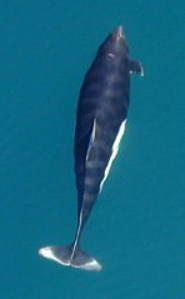
The
Dall's Porpoise (
Phocoenoides dalli) is an incredible swimmer with turquoise eyes and the ability to breathe air while rushing through the water at top speeds. These amazing porpoises love bow-riding, yet are shy around humans, and are some of the fastest mammals riding the waves in the North Pacific.
The Dall's porpoise is robust and muscular, particularly through the middle. The head is small and rounded, which makes it look smaller than it really is. The beak is small and poorly defined. The small mouth has a bit of an under bite, and their teeth are ideal for helping them hold on to the slippery prey. This animal looks a bit out of proportion because of an additional hump located on the bottom of the body. One of the amazing features of the Dall's porpoise is their colored eyes. The iris is black or dark blue with a deep, iridescent turquoise colored pupil.
Their coloring is typically black on the top with white bellies and white sides. One of the smaller porpoises, males are typically 7.5 feet (2.29 meter) long while females are typically 6 feet (2.1 meters) long. Weights for both males and females are typically about 270 pounds (123 kg). They can get larger, however. The largest recorded to date weighed in at 480 pounds, or 220 kg.
This amazing swimmer can only be seen in the wild in the North Pacific. Their territory ranges from Baja, California all the way to Alaska, through the Bering Sea and into the waters of Japan. They prefer the cooler temperatures of the water and typically stay where the water temperature is below 60 degrees F (15 C).
The Dall's porpoise can go as fast as 30 knots. It loves bow-riding with fast vessels, but will avoid contact with the people on board. When dashing through the water its head and back move in unison to create a unique spray of water known as a "rooster tail". This movement actually creates a hollow cone in the water that will allow the porpoise to breathe without surfacing.
They are not currently endangered, although they are in need of protection due to the growing fishing industry. Thousands of Dall's porpoises are caught in Japanese nets set out for salmon and squid. Other threats to this impressive swimmer include pollutants and other contaminants in the water. Steps are currently underway to protect this species and preserve it for the future.
They dine on small fish; specifically squid, capelin, herring, and sardines. They also enjoy hake, smelts, and lantern fish. A largely nocturnal animal, it mainly feeds at night and will consume between 28 and 30 pounds (12.7 - 13.6 kg) per day. Natural predators of these porpoises include killer whales and sharks. However, they are able to use their small size and quick movements to their advantage as they escape these predators.
You can help spreading the word about this animal by liking it on facebook
Permanent Link
Monday 20 June 2011
Pygmy Planigale - carnivorous marsupial
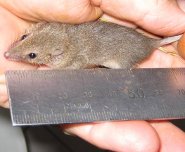
The
Pygmy planigale (
Planigale maculata) is a small marsupial which can be found in parts of Australia, as well as the islands of Groote Eylandt and Great Keppel. This creature's appearance resembles a cross between a mouse and a shrew.
When looking at this critter, it appears small, measuring 180 millimeters (18 centimeters) in length. The males of this species weigh 15 grams (0.53 ounces) and the females average around 11 grams (0.39 ounces). The resemblance is remarkably similar to that of the house mouse, with the exception of their pointy head and large round ears.
This small creature, whose scientific name translates as "spotted flat-weasel", is covered in coat of reddish or grey fur. Their underside is lighter in color and appears to be a mix between light grey and yellow. Their fur extends around the entire body, stopping at the tail which is almost completely naked. Their marsupial pouch is located on the bellies of the females opening towards the back. Females give birth to between five and eleven young at a time, who crawl into the pouch to suckle, and then emerge twenty-eight days later. These young go out on their own at seventy days old.
The pygmy planigale can be found in a variety of locations including rainforests, heathland, grasslands, forests, and marshlands. Generally, they prefer to live near water in places that have thick cover under which they can hide from their predators. Additionally, community nests built by the pygmy planigale have been found in the wild.
This nocturnal marsupial is a carnivore whose diet mainly consists of insects and arthropods. They are known to bite the bellies of insects in order to kill their prey where they are most vulnerable. This little creature has also been known to take down prey larger than itself, including small birds and lizards. The pygmy planigale needs to keep a lookout for their predators which include foxes, cats, and cane toads.
Although the pygmy planigale is not on the endangered species list, their numbers are not precisely known. Some members of the scientific community believe that they are being threatened as their natural habitat is being developed and destroyed.
Steps can be taken to ensure the pygmy planigale continues to thrive in Australia. Reduction in burning of forests and control of cattle's access to grazing land near the pygmy planigale's territory may help this species thrive.
You can help spreading the word about this animal by liking it on facebook
Permanent Link
Wednesday 15 June 2011
Uinta chipmunk - Nature's Re-seeding Heir Line
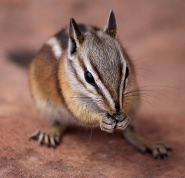
The
Uinta chipmunk (
Tamias umbrinus), is a small mammal of the Rodentia order. Their native habitat is amongst coniferous trees in 8 states located in the Western United States. Utah, Nevada, and parts of Arizona, Colorado, California, Idaho, Wyoming and Montana are the places where this tiny furry forest denizen lives. Although the chipmunk is mostly arboreal, typically nesting in or within trees, it may burrow under rocks, logs or brush.
The Uinta chipmunk is in a medium range of size and weight for chipmunks, weighing in at about 59g and at about 225mm long. As is the case with Tamias in general, the females outsize the males. Their coloration is slightly different with regards to the stripes on their backs, but for the most part, they look very similar to other species of chipmunks.
Typically, they have large fur-lined cheek pouches for collecting food to be transferred to their nests and other caches where they store food for the winter months. Their diet consists mainly of berries, nuts, fruit, conifer mast, and maple, chokecherry and juniper seeds. Occasionally, however, they will supplement that with pollen, fungi, insect larvae, buds and even birds' eggs.
Due to their propensity to hide and eat seeds, the Uinta is also largely responsible for the spreading of seeds in the forest, resulting in a helpful regeneration of timber. Their contribution to the growth of new trees is substantial and is their most helpful benefit to humans.
In the spring, after their hibernation period ends, they build their nests in underground burrows, tree cavities, or even birds' nests that have been abandoned. Being promiscuous in nature, either sex may mate with multiple mates; permanent pairing is not a part of their mating habits.
Their matings typically occur in the spring after hibernation and nesting. Litters consist of 4 to 5 young after approximately one month of gestation. The young are nursed for a month or two until the young are able to fend for themselves. Before the following winter, the young will have separated from the nest and dispersed to live their own lives. By the following spring, they are mature and will reproduce. Their lifespan is about 8 years.
Predators of the tiny chipmunk are typically weasels,
red or
gray foxes and their kits,
bobcats,
coyotes, hawks and other raptor type birds.
Tiny though they are, their contribution to the forest is immeasurable.
Picture of the uinta chipmunk by Tdomhan, licensed under
Creative Commons Attribution-Share Alike 3.0 Unported license.
You can help spreading the word about this animal by liking it on facebook
Permanent Link
Thursday 09 June 2011
Clymene Dolphin - the Mustachioed Spinner

The
Clymene Dolphin (
Stenella clymene) is an amazing creature that can be found in the Atlantic off the United States and into the Caribbean and as far south as South America. They are highly intelligent and playful animals that often travel in pods and even intermingle with other types of dolphins.
At one time, the Clymene dolphin was thought to be a subspecies of the
Spinner dolphin and is often referred to as the short-snouted spinner. In fact, the Clymene is different enough from the Spinner to warrant separate classification. The similarities between the Clymene and the Spinners include their coloration both being light grey with a darker shade on top. The Clymenes however differ in the fact that they have a shorter snout with facial markings that resemble a mustache. Clymenes dolphins also exhibit behavior that is much like the Spinner dolphins. Both of these dolphins ride the waves and spin in the crest. The difference here is that the Spinner dolphin whose name is derived from this behavior is far more agile and graceful at this feat than their Clymene cousin. Clymenes are active and while their spinning is not nearly as complex as the Spinner dolphins they do enjoy jumping, leaping, and playing in the waves.
The average length of a full grown Clymene is about 6'6" or 2 metres. Little is known about juvenile or infant Clymene dolphins such as their size and weight at such an early age. These dolphins can weigh up to 200 pounds (90kg) with a diet consisting mostly of small fish and squid.
Like most dolphins the Clymene are extremely curious and intelligent animals and will often approach boats and swim alongside it to the delight of the passengers. It is rare to see this type of dolphin from the shore but can easily be spotted in open waters often swimming in pods that reach up to 500 in number. The exact population number of the Clymene dolphins is unknown and it has been suggested that their species may be rare.
Generally human interaction with these dolphins has been a deadly one. Many fishermen will on occasion, kill Clymenes to use as shark bait. The dolphins have also been known to get caught up in nets and in Venezuela fisherman will kill Clymenes to prevent the dolphins from eating the fish that the fishermen wish to catch.
Clymene dolphins are graceful and fascinating with much of their behavior and lifestyle unknown. Further research and study is needed to fully understand the intricacies of this animal and it's way of life.
You can help spreading the word about this animal by liking it on facebook
Permanent Link
Monday 06 June 2011
The Rock Squirrel - On the lookout
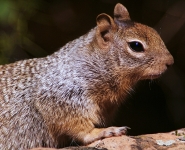
The
rock squirrel (
Spermophilus variegatus) has its origins in the Americas, Eurasia and Africa, but now primarily resides in the southern United States and Mexico. Nevada, Arizona, Texas, Colorado and the panhandle of Oklahoma are all home to the rock squirrel. They are typically found in shady areas without excessive ground cover and on slopes or rocky areas, which provide lookout points used to scope out predators. It is common for rock squirrels to burrow near Oak trees or Mesquite bushes and prefer proximity to washes or other water sources.
The rock squirrel is larger than many of its squirrel cousins, with an average adult length ranging from 17 - 21 inches (43-53 cm), and weighing between 19 and 23 ounces (538-652 grams). Males are typically larger than females, and the bushy tails add approximately three inches (7.6 cm) in length.
There are a number of predators that stalk rock squirrels, including hawks, roadrunners,
coyotes and snakes. The rock squirrels' main defense against these predators is the speed of their retreat and their strong vision, which enables them to warn fellow squirrels to retreat to their burrows when danger is sensed.
With sharp claws and powerful legs, the rock squirrel was designed for digging. Their underground dens or nests are sometimes connected through tunneling. This provides protection from predators and shelter from the harsh heat of the summer days. Rock squirrels are diurnal and do not hibernate in the traditional sense, although they are found to be more active in the warmer seasons.
Rock squirrels are not terribly discerning when it comes to their diet. As omnivores, they will forage for leaves, roots, seeds, plants, insects, caterpillars and are happy to feed off the remains of a dead animal. With their four front teeth that never stop growing, they are well suited to gnaw on whatever food sources they can find.
With the ability to produce two litters per year of two to eight babies each, Rock squirrels are plentiful and show no signs of becoming endangered. Human encroachment on their habitats has actually helped then perpetuate, because this has caused their predators to diminish in number. These mammals are interesting to observe and are known for their sociability. Although tempting to approach, it is not recommended because like most wild animals, they can carry disease such as the plague and rabies.
Picture of the rock squirrel by Tadam at pl.wikipedia, licensed under
Creative Commons Attribution-Share Alike
You can help spreading the word about this animal by liking it on facebook
Permanent Link
Thursday 02 June 2011
Brown Rat - A Rat By Many Other Names
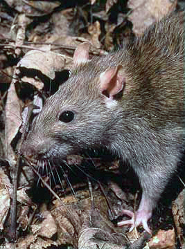
The
brown rat (
Rattus norvegicus) is the most common rat on earth. It lives on every continent except
Antarctica, and especially loves to settle in urban environments.
This rodent goes by many names: Norway rat, sewer rat, wharf rat and common rat. Brown rats are believed to have originated in northern China, following human settlements on ships and by land. Rough, brown-to-gray fur covers a body 25 cm long (10 in), with a hairless tail equal to the body's length. The average weight of male brown rat is about 500 grams, though they can get much heavier if the environment supports them. Females are generally smaller, weighing in at a slimmer 350 gm (.75 lb).
Brown rats have poor vision, compensated by an extraordinarily acute senses of smell and hearing. They are nocturnal and extremely agile in their foraging habits. Brown rats can climb trees, run along the tops of fences, tiptoe along power lines and climb walls. They can fit through the tiniest of gaps and cracks if food is smelled on the other side.
Sewers are the perfect environment for brown rats, but they can also be found in homes, near farms, barns, garbage dumps, landfills and alleys. Brown rats are social animals and develop "pecking orders" in their groups that are based on food availability. They eat almost anything, and their diet depends on their surroundings. They can catch small fish and young birds, but also eat fruit, nuts and grains.
Female brown rats are prolific breeders and are able to mate when they reach the age of 11 weeks. A single female rat can produce up to five litters of 7 to 11 pups per year. With such a high rate of reproduction, the species is not endangered in any way, though the average rat only lives for about one to two years in the wild.
Contrary to popular wisdom, brown rats are not a vector for bubonic plague. They are however, carriers of a number of diseases that afflict humans. Trichinosis, hemorrhagic fever and cryptosporidiosis are a few of them. Rat droppings in great quantities can become aerosolized and inhaled, causing hantavirus pulmonary syndrome.
Brown rats have a number of predators that control their numbers. Large birds, foxes, wolves, cats, dogs and large reptiles like alligators, crocodiles and boa constrictors feed on brown rats. Though the human race is constantly seeking to stamp them out, the brown rat is here to stay.
You can help spreading the word about this animal by liking it on facebook
Permanent Link
 The Dall's Porpoise (Phocoenoides dalli) is an incredible swimmer with turquoise eyes and the ability to breathe air while rushing through the water at top speeds. These amazing porpoises love bow-riding, yet are shy around humans, and are some of the fastest mammals riding the waves in the North Pacific.
The Dall's Porpoise (Phocoenoides dalli) is an incredible swimmer with turquoise eyes and the ability to breathe air while rushing through the water at top speeds. These amazing porpoises love bow-riding, yet are shy around humans, and are some of the fastest mammals riding the waves in the North Pacific.
 The
The  The
The  The
The  The
The  The
The